|
|
 |
|
Calanoida ( Order ) |
|
|
|
Arietelloidea ( Superfamily ) |
|
|
|
Augaptilidae ( Family ) |
|
|
|
Pseudhaloptilus ( Genus ) |
|
|
| |
Pseudhaloptilus pacificus (Johnson, 1936) (F,M) | |
| | | | | | | Syn.: | Pachyptilus pacificus M.W. Johnson, 1936 (p.65, Descr.F, figs.F); Brodsky, 1950 (1967) (p.392, figs.F); Minoda, 1958 (p.253, 255: occurrence); Tanaka, 1964 b (p.88, fig.F, Rem.M); Grice & Hulsemann, 1967 (p.37, Rem.); Minoda, 1971 (p.42, 52, fig.F); Vidal, 1971 a (p.11, 117, figs.F); Tanaka & Omori, 1971 (p.267); Gardner & Szabo, 1982 (p.392, figs.F); Buchanan & Sekerak, 1982 (p.41, Table 2: vertical distribution, Rem.: p.48); Ali-Khan & Ali-Khan, 1984 (p.310, figs.F, Rem.); Heinrich, 1990 (p.19, 22, figs.F); Chihara & Murano, 1997 (p.729, Pl.56: F); Ikeda & al., 2006 (p.1791, Table 2); Schnack-Schiel & al., 2008 (p.1045: Tab.2); Homma & al., 2011 (p.29, Table 2, 3, abundance);
Pachyptilus eurygnathus : Sewell, 1947 (p.239, figs.F, Rem.);
Pseudhaptilus pacificus : Galbraith, 2009 (pers. comm.);
Ref. compl.: Grice & Hulsemann, 1967 (p.19); Park, 1970 (p.478); Björnberg, 1973 (p.348, 388); Kosobokova, 1989 (p.26); Hanssen, 1997 (tab.3.1); Padmavati & al., 1998 (p.347); Kosobokova & Hirche, 2000 (p.2029, tab.2); Yamaguchi & al., 2002 (p.1007, tab.1); Kazmi, 2004 (p.227) | | | | Ref.: | | | Boxshall & Halsey, 2004 (p.69: fig.F) | 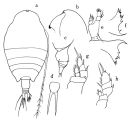 issued from : O. Tanaka in Publs Seto Mar. Biol. Lab., 1964, XII (1). [p.89, Fig.218]. As Pachyptilus pacificus. Female: a, habitus (dorsal); b, forehead (left lateral side); c, last thoracic segment and urosome (left lateral side); d, rostrum (frontal view); e, left Md; f, masticatory edge of right Md; g, P1; h, P5. Nota: The urosome segments and furca are in the proportional lengths as 50:12:8:10: 20 = 100. A1 exceeds the end of the furca by distal 4 segments.
|
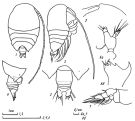 issued from : A.K. Heinrich in Trudy Inst. Okeanol., 1990, 124. [p.23, Fig.2]. As Pachyptilus pacificus. Female (from SE Pacif.): 1, habitus (dorsal); 2, idem (lateral right side); 3, urosome (dorsal); 4, last thoracic segment and urosome (lateral right side); 5, forehead (lateral); 6 a,b, Md (mandibular palp and cutting edge, respectively); 7, P1 (from profile).
|
 issued from : R.B.S. Sewell in The John Murray Expedition, 1933-34, Scientific Reports, VIII (1), 1947. [p.240, Fig.65]. As Pachyptilus eurygnathus. Female (from G. of Oman): A, A2; B, Md; C, Mx1; D, Mxp; E, P1; F, P5.
|
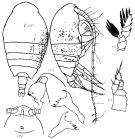 Issued from : K.A. Brodskii in Calanoida of the Far Eastern Seas and Polar Basin of the USSR. Opred. Fauna SSSR, 1950, 35 (Israel Program for Scientific Translations, Jerusalem, 1967) [p.392, Fig.279]. As Paachyptilus pacificus. Female (from NW Pacif.): habitus (dorsal and lateral right side); GVe, forehead (ventral); GLa, idem with protruding labrum (lateral); M, Md (masticatory blade); S1, P1; S5, P5. Nota: Cephalotorax, especially the lateral part and the protruding part of the labrum, covered with shining refractile specks, resembling hardened droplets of fat.
|
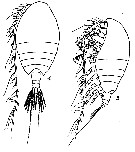 issued from : M.W. Johnson in Bull. Scripps. Instn. Oceanogr., tech. Ser., 1936, 4 (2). [p.67, Fig.A, 4-5]. Female (from 49°20'N, 174°31'W): 4-5, habitus (dorsal and lateral, respectively). Nota: 5th thoracic segment with moderately pointed margins. Urosome about 1/4 the length of prosome. Genital segment about equal in length to the 3 abdominal segments combined. Caudal rami slightly longer than the anal segment. 2nd inner caudal setae much longer than the others. A1 extending beyond the caudal rami by approximately the 4 end segments
|
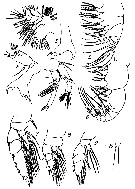 issued from : M.W. Johnson in Bull. Scripps. Instn. Oceanogr., tech. Ser., 1936, 4 (2). [p.68, Fig.B]. Female: 1, Mx1; 2, right Md; 3, left Md (mandibular blade); 4, A2; 5, Mx2; 6, Mxp; 7, P3; 8, P1; 9, P5; 10, rostal filaments. Nota: Labrum very large and armed with a posterior tuft of short rigid spinules. A2 7-segmented. Mandibular blades very strongly developed. P5 symmetrical, exopod 3-segmented and endopod 1-segmented with 4 setae.
|
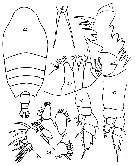 issued from : S. Ali-Khan & J. Ali-Khan in Crustaceana, 1984, 47 (3). [p;311, Figs.44-51]. Female (from 24°09'N, 64°27'E): 44, habitus (dorsal); 45, rostrum; 46, right Md (biting edge); 47, left Md (biting edge); 48, Mx1; 49, Mx2; 50, P1; 51, P5. Nota: There is no spine on lobe 4 of Mx2 as noted by Tanaka (1964). Johnson's (1936) figure of the A2 which shows the outer lobe of the endopod as a segment, seems an artifact, and similarly the 3 lateral spines shown on the 3rd exopodal segment of right P5 are either incorrect or present an abnormal case, since the same segment of left P5 of Johnson's specimen has 2 spines and all other species in this genus also have 2 lateral spines.
|
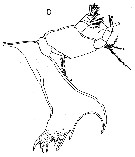 Issued from : G.A. Boxshall & S.H. Halsey in The Ray Society, No 166, 2004. [p.69, Fig.7, D]. Female : D, Md.
| | | | | Compl. Ref.: | | | Fernandes, 2008 (p.465, Tabl.2); Kosobokova & Hopcroft, 2010 (p.96, Table 1, fig.7); Medellin-Mora & Navas S., 2010 (p.265, Tab. 2); Kosobokova & al., 2011 (p.29, Table 2, 3, Rem.: Arctic Basins); Smoot & Hopcroft, 2016 (p.1, Rem.: p.5: occurrence) | | | | NZ: | 9 | | |
|
Distribution map of Pseudhaloptilus pacificus by geographical zones
|
| | | | | | | | |  Chart of 1996 Chart of 1996 | |
| | | | Loc: | | | Antarct. (W Weddell Sea); Sub-Antarct. (off S Chile), Bering Sea, S Aleutian Basin, S Aleutian Is., Arct. ( Laptev Sea, Canadian abyssal plain, Beaufort Sea, Makarov Basin, Canada Basin, W Baffin Bay), Strait of Queen Charlotte, Vancouver Is., off SE Hokkaido, Station Knot (44°N, 155°E), Japan (Sagami Bay, NE), Pacif. (SE tropical), Bay of Bengal, G. of Oman, W Indian, Arabian Sea, Pakistan, Caribbean Colombia. | | | | N: | 30 | | | | Lg.: | | | (22) F: 6,25-5,8; (69) F: 5,5; (90) F: 6,18-5,97; (208) F: 6,5; M: 4,6; (315) F: 4,76; {F: 4,76-6,50; M: 4,60} | | | | Rem.: | Meso-bathypelagic.
For Kosobokova & Hopcroft (2010) this species is a Pacific form expatriate in Arctic Basin. | | | Last update : 26/01/2017 | |
|
|
 Any use of this site for a publication will be mentioned with the following reference : Any use of this site for a publication will be mentioned with the following reference :
Razouls C., Desreumaux N., Kouwenberg J. and de Bovée F., 2005-2025. - Biodiversity of Marine Planktonic Copepods (morphology, geographical distribution and biological data). Sorbonne University, CNRS. Available at http://copepodes.obs-banyuls.fr/en [Accessed January 02, 2026] © copyright 2005-2025 Sorbonne University, CNRS
|
|
 |
 |











